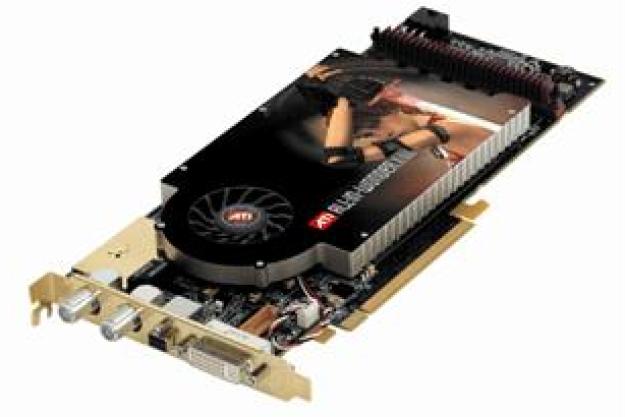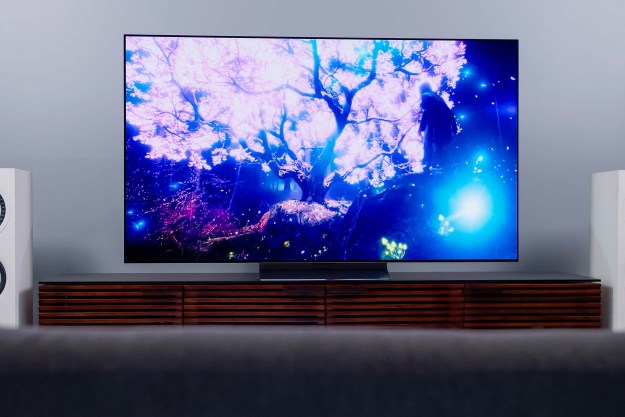
“The AIW X1900 presents a good value to those looking to upgrade their older video card...”
- Powerful GPU
- great for gaming; good software package; solid value
- Old video decoder chip; too large for a lot of PC's; underclocked GPU
Summary
ATI’s latest All-in-Wonder card, the AIW X1900 uses the company’s latest and great GPU, borrowed from the X1900 series gaming cards, and includes video capturing and editing capabilities as well as an integrated television tuner complete with PVR and TV On-Demand functions. The X1900 GPU is a remarkable processor that performs extremely well in 3D environments; perfect for gamers. We have always been impressed with the premise behind the All-In-Wonder philosophy and we are still surprised to see ATI the only video card company to implement a product-line behind a video card that basically does everything. Previous All-In-Wonder cards that we have reviewed have pretty much been hit or miss, so we are excited to see what ATI has brought to the table this time around.
Features and Design
The first thing you should know about the AIW X1900 is that it uses the same GPU core as the X1900 XT and XTX. The second thing you should know is that its core clock speed is clocked slower than the two aforementioned cards, 500MHz compared to 625MHz in the XT and 650MHz in the XTX. So if you plan on buying this card primarily for gaming and just want a few extras, you should be fine. If you are a hardcore gamer, get the XT or XTX and then maybe add the TV Wonder Elite if you want a TV tuner card.
The AIW X1900 comes in the PCI-Express x16 flavor for the time being, although an AGP version might be introduced later on, but don’t quote us on that. The AIW X1900 has a few new tricks that separate it from All-in-Wonder cards of the past. Using ATI’s new Avivo and H.264 HD technology the AIW X1900 will give you High-Definition quality visuals on your PC depending on the content that is being played. H.264 Acceleration is used to decode Blu-ray and HD-DVD media on the PC. Please visit ATI’s website to read more information about AVIVO and H.264 and to download the H.264 decoder for your PC. As we saw at this years’ CES you can expect Blu-ray recorders for your PC to hit very soon, followed by players for the home. If anything, this new AVIVO and H.264 technology will give longevity to the AIW X1900; you should also expect to see it featured on future ATI video cards as well.
The TV tuner on the AIW X1900 has been upgraded several times over the years starting with a Philips tuner and moving to the Microtune MT2050. This year however, the tuner gets upgraded once again, this time featuring the Microtune 2121 chip. According to ATI, the new Microtune 2121 is physically smaller than previous tuners, yet it changes channels quicker, and combined with ATI’s Theater 200 video decoder its suppose to provide better image quality when reproducing over-the-air or analog cable content. The Microtune 2121 tuner will not work with HDTV, digital cable, or satellite broadcasts; you will have to buy a separate tuner card for those. On the PCB board, the Microtune 2121 tuner box is cut in half with each half located on a side of the video card. This helps to make room for the large cooling assembly which overlaps a little bit of the tuner box. The AIW X1900 is capable of receiving up to 125 channels on your computer. If you add another tuner card, the ATI software will let you watch two programs using Picture-in-Picture.
At the heart of the AIW X1900 is the Theater 200 video decoder chip which is used to decode all of the video aspects of the card. The Theater 200 decoder has been around a long time, at least 3 or more generations of All-In-Wonder cards and in our opinion should have been replaced by the Theater 550 Pro chip on the AIW X1900. We tested the ATI TV Wonder Elite which uses the new Theater Pro 550 chip last year and were impressed with its video quality.

ATI packages the Remote Wonder Plus with the AIW X1900 and this is what you will use for most of your television and video playback. The Remote Wonder Plus is a decent remote that gives you most of the functions you will need. It’s not as robust as the Remote Wonder II, but we can understand why ATI chose it instead; it helps keep the overall price down. If you want to buy a Remote Wonder II it should work with this video card.
On the software side, you get ATI’s own Multimedia Center software for recording shows for playback later, for viewing video files and for viewing television broadcasts and more. This is really where you will spend most of your time when using this card. The Media Library software organizes all of your media into one place so you can access them easily. ATI has decided to ditch the Pinnacle software in favor or Adobe Premiere Elements 2.0 and Photoshop Elements 4.0. These two programs alone help to make the included software package one of the best we have seen with a video card in a long time.
Image Courtesy of ATI Technologies
Performance



Designtechnica Test System
Windows XP Professional; Intel LGA 775 3GHz CPU; 1GB Crucial Ballisitx DDR2 533MHz RAM; Western Digital 7200RPM SATA 80GB hard drive
Setup and Use
ATI didn’t send us a final manual with the AIW X1900 so we can’t tell you how well they describe the setup process; we went in blind folded so to speak.
You must have a pretty hefty system in order to meet ATI’s requirements for using this card. You will need a PCI-Express x16 based motherboard, at least a 450watt power supply, a Pentium 4/Celeron or AMD Athlon class processor and at least 256MB of system memory. We also want to warn you that this is a huge card, measuring in at 10-inches long. We had trouble getting this into our test system, and were forced to move the hard drive in order to get it into the case. If you have a small case, this card is out of the question, and if you have a store bought system, make sure you buy this card from a store with a good return policy because there is a chance it won’t fit into your system either.
Once we installed the card and plugged in our monitor, the FM antenna and our cable TV, we fired up our system and prepared to install the software. Surprisingly, we were able to install the Catalyst software without it crashing our system even once. It took about 10 minutes to get everything installed and required a couple restarts during the process.
The Gemstar Guide Plus software scanned our incoming cable signal and programmed all of the stations for viewing. You can use the guide separately as with ATI’s Multimedia Center Software or you can use ATI’s new EazyLook Multimedia Center software which acts like a Media Center type front-end, allowing you to choose which operation you want. The new GUI looks great and does a fantastic job of tying all of the applications together.
For the most part everything worked as advertised. You really need to sit down and spend a good 4-5 hours playing with everything before you can fully understand how to use this card. ATI has done a great job getting multiple applications and products to work together, but a little more polish would be nice. We sometimes encountered a software crash and at times it felt like minutes before the software would load.
If you have a PC running Microsoft Windows Media Center Edition, the AIW X1900 is completely compatible. It will use the TV and FM radio tuners on the AIW X1900. We recommend that you use the MCE operating system as the default GUI for accessing your recorded shows and media though. The Remote Wonder II will work with MCE so you don’t need to buy another remote control.
Image Courtesy of ATI Technologies
For those of you looking to build an HTPC or MCE PC from scratch rather than adding this card to your existing Media PC, we recommend that you get an X1800 or lower card and then add the ATI TV Wonder Elite tuner card and a Hauppauge HDTV card to your system. The ATI TV Wonder Elite tuner card features the Theater 550 PRO video decoder which is better than the Theater 200 found on the AIW X1900, plus you can upgrade your video card in the future without having to buy a new tuner card. Another issue we found is that due to the sheer size of the AIW X1900 card (10 inches long) is simply will not fit in most Media Center PC’s, plus the heat sink and fan puts out a lot of heat and noise making it more ideal for a desktop PC.
When it comes to games, the AIW X1900 is a solid performer. It’s not as fast as the X1900 XT or XTX and the Nvidia 7800GTX passes it up too, but the AIW X1900 does a great job on all but the most demanding games; you will have no problem playing Battlefield 2 at 1600×1200 resolution with 4XAA turned on. For complete game benchmarks, please click on the performance tab and link located above and below this review.
Conclusion
We have said this a hundred times and we are going to say it again. Buy the AIW X1900 for its gaming and video capturing and editing capabilities. If you are planning on buying it for a home theater or Media Center PC, pass it up. Buy a smaller graphics card and then an ATI Theater 550 Pro based tuner card and good HDTV tuner card; you will be much better off.
The AIW X1900 only really only improves upon older AIW cards with the newer graphics chip and that’s about it. It still uses the older Theater 200 tuner chip, the electronics program guide and the ATI Multimedia Center software looks the same and is not really a good software suite for a full-fledged Media Center PC. And measuring in at 10-inches, this card will be incredibly hard to get into most custom-made PC’s let alone a store bought one.
That being said, the AIW X1900 presents a good value to those looking to upgrade their older video card for one that does a little bit of everything. The Remote Wonder is a great remote control and the software package is fantastic. In the end, the AIW X1900 needs some more polish and a real identity.
The AIW X1900 really belongs at home in a desktop geared for multimedia buffs or for someone living in a dorm room or similar environment where space is important.
Pros
-
- Powerful GPU, great for gaming
-
- Excellent software package
- Presents a good overall value
Cons
-
- Way to large, hard to fit into a desktop PC
-
- Older video decoder chip
-
- No HDTV tuner
-
- Only encodes video in MPEG2, not MPEG4
- GPU clock speed is lower than X1900 XT counter-part
Editors' Recommendations
- Alienware x14 R2 and x16 hands-on review: XPS gaming laptops?
- Reviewers agree: The M2 MacBook Air has a heat problem
- Computex 2022: All X670 motherboards announced
- Lenovo Slim 7i Pro X hands-on review: A do-it-all laptop
- Lenovo Slim 9i 14 hands-on review: All luxury




